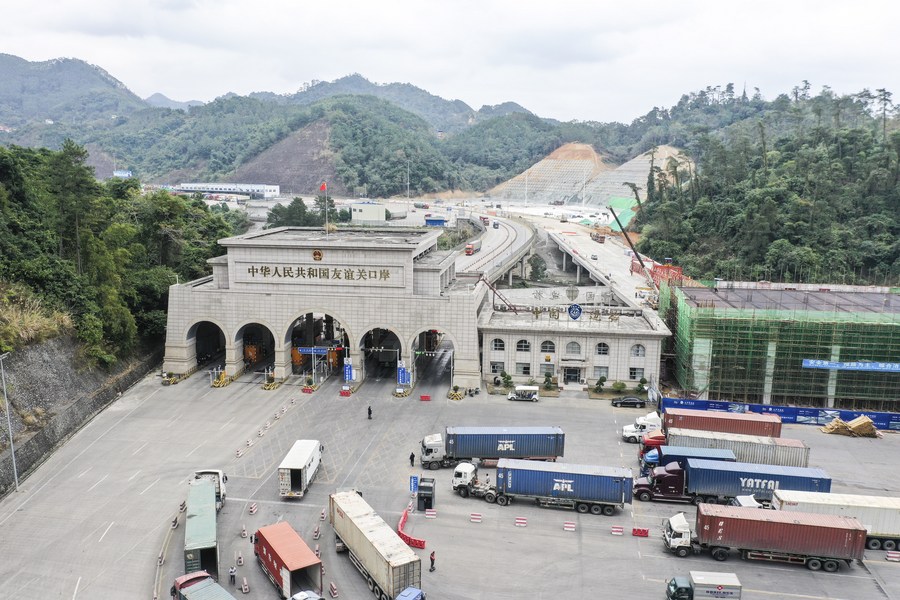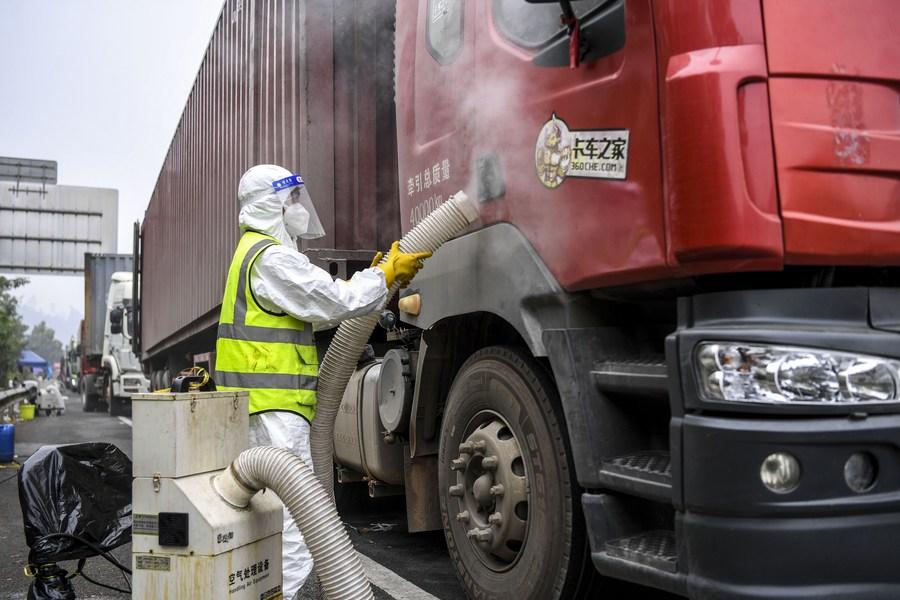
Aerial photo taken on Jan. 3, 2020 shows vehicles waiting to pass the port of the Friendship Pass on the China-Vietnam border in Pingxiang, south China's Guangxi Zhuang Autonomous Region. (Xinhua/Cao Yiming)
NANNING, Feb. 5 (Xinhua) -- Youyi Port in Pingxiang City, south China's Guangxi Zhuang Autonomous Region, is still busy during the Spring Festival this year.
Lyu Jinfu, a freight forwarder, was busy handling documents and guiding trucks to move.
For epidemic prevention and control, Lyu has not been able to go home for eight months and has spent every day in closed-loop management. "On New Year's Eve this year, I made a video call to my families," said Lyu.
Cross-border driver Yu Zhijun also began a busy day early. He drove a truck loaded with mangoes, longan, and other Vietnamese fruits, passed through the intelligent customs clearance scheduling system from the checkpoint, and entered the designated warehouse through the port for goods transfer.
"There are so many goods these days that I have to make seven or eight trips a day," Yu said. In Pingxiang, there are now more than 300 freight forwarders and cross-border drivers commuting between the port and warehouses every day, up to more than 600 at peak times.
Youyi Port is an important exit and entry channel for people, as well as a main land channel from China to ASEAN destinations, with frequent cross-border personnel and goods exchanges. Since the outbreak of COVID-19, over 700 personnel and 1,300 vehicles enter and leave the port on a peak day.
The local government has strictly implemented epidemic prevention and control measures to prevent imported cases, ensure the smooth flow of cross-border channels, and safeguard the security of China's southern border.

A staff member disinfects an inbound vehicle at the Youyi Port in Pingxiang City, south China's Guangxi Zhuang Autonomous Region, Nov. 16, 2021. (Xinhua/Cao Yiming)
In 2021, Youyi port's foreign trade continued to grow. It saw a total of 402,800 inbound and outbound freight trucks and about 4.4 million tonnes of import and export cargo.
According to Yu Ruida, deputy director of Pingxiang Commerce and Port Administration, the local government has innovatively introduced a customs clearance agent driving system for cross-border drivers, and all Chinese freight vehicles entering and leaving the port are driven by designated cross-border drivers who are strictly under closed-loop management.
Besides, cross-border vehicles are comprehensively disinfected, and imported goods can enter China only after undergoing nucleic acid testing, disinfection and other procedures.
At the Beitou warehouse in Pingxiang, cars with Vietnamese or Chinese license plates shuttled back and forth, and staff in protective suits were busy loading and unloading goods.
According to Zhang Yaoquan, manager of the warehouse, all goods from overseas need to have nucleic acid testing first, and only if the result of the test is negative can they be loaded and unloaded.
Fruits from ASEAN countries enter the Chinese market through Youyi Port every day. "Our company carries many durian, dragon fruit, longan, and other ASEAN fruits," said Su Yu, head of the operation Department of Guangxi Xiangxiang International Logistics Co., LTD.
According to Su, now both the port and the company have attached great importance to the safety of cross-border cold chain logistics, and have made every effort to prevent products with the virus from entering China.
"Despite the impact of the epidemic, customs clearance at Youyi Port has remained relatively efficient," said Su, adding that with the support of local customs and other departments, goods from China can be delivered to Bangkok in four or five days.
Su is quite optimistic about the development prospects of the company. "Now China and the ASEAN have become each other's largest trading partners and the Regional Comprehensive Economic Partnership agreement has also officially come into effect, so we are expecting to enjoy closer regional economic and trade exchanges," said Su.




 A single purchase
A single purchase









